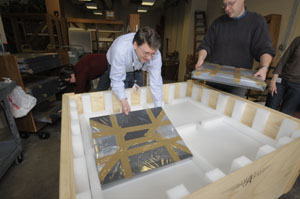
Ransom Center Curator of Photography David Coleman shares his thoughts on the Magnum Archive Collection coming to the Center. At that same link, view a video of Magnum Director Mark Lubell discussing the significance of the Magnum Archive Collection.
The roster includes more than 95 photographers who would, on their own, make up a definitive who’s who list of photography for the past six decades. More significantly, however, they compose what is perhaps the most recognizable single organization in 20th-century photography: Magnum. Magnum has never been the largest photo agency, but for more than 60 years the cooperative’s notoriously exclusive process of membership has forged an ever-changing band of photographers who are dedicated to communicating through images taken with a unique eye.
Magnum was established to afford some independence for its member photographers from the most controlling and limiting aspects of the media industry, and this freedom and flexibility has allowed the photographers to remain with a particular story, rather than having to fly from hot spot to hot spot like many magazine photographers. Indeed, Magnum’s hallmark has always been the depth with which its photographers have captured their subjects—operating as much or more in what might be termed a “documentary” sphere than one of pure photojournalism. In recent decades, that sphere has further broadened to include elements of art and a self-conscious personal expression. Yet Magnum’s overall purpose of revealing the complex world to itself has remained unchanged.
The nearly 200,000 images now housed at the Ransom Center include iconic as well as lesser-known images by these masters of photography, covering historic events and celebrations, political figures and movie stars, intense studies of urbanism and humanity, and documents of war, terror, murder, and atrocity. The depth of coverage by individual photographers is often multiplied by the number of photographers that cover a particular event or figure. For example, looking through the Martin Luther King, Jr. box, we find images taken by Bob Adelman, René Burri, Henri Cartier-Bresson, Bruce Davidson, Leonard Freed, Burt Glinn, Erich Hartmann, Bob Henriques, Hiroji Kubota, Danny Lyon, and Costa Manos.
The Ransom Center is delighted to have been chosen by MSD Capital to safeguard a substantial and unique piece of history. We look forward to joining in partnership to further Magnum’s future by protecting and promoting the study of its history.
In talking with Mark Lubell, Director of Magnum Photos, about the many photographers who have been part of the cooperative, I was struck by his description of them as “visual authors.” Given the Ransom Center’s broad range of holdings of the greatest writers, poets, and playwrights, as well as photographers and other visual artists, we expect that our newest “authors” will find a nurturing home here. If we consider the humanities to be the serious contemplation of the human condition, we could certainly not find a more appropriate collection to welcome than the Magnum archive.

